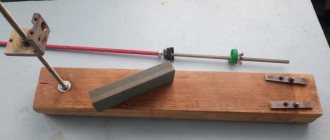Wire is considered a universal material from which you can create a huge number of crafts. Craftsmen and craftswomen use different types of wire in their creative work, combining it with other materials (beads, scraps of fabric, plasticine).
A creative approach allows you to create original crafts in the form of three-dimensional figures, interior elements, various brooches, and toys. Even children, without any experience at all, love to create beautiful, unique things using this material.
Due to its properties, simplicity and ease of use, wire has become a favorite for home creativity among adults and children.
Wire and decorations
Wire is the most important material that you can find in craft stores. It comes in different colors and textures, but as a rule, the base copper color is the most affordable.
This is what we recommend using for your first works, and only then moving on to more expensive color ones. Also, keep in mind that you can complement your crafts with any decorations, for example, beads, beads and any other material.
In addition to regular wire, you can find flat wire of various widths, twisted and even plastic threads. Usually preference is given to copper, since it is an extremely malleable, soft metal. Children and toddlers will enjoy fiddling with chenille wire because of its slight frills.
Piglet
A child can make a pig's face from fluffy wire with his own hands. To do this you will need pink chenille wire, adhesive-backed doll eyes, two small black pieces of fluffy wire for the snout (can be replaced with two black cardboard circles).
- Twist a large piece of pink wire into a flat spiral to create a circle.
- From a smaller piece, twist a small circle, 2 times smaller in size. This will be the pig's snout.
- Fold two small pieces of wire at an angle and screw them to a large circle-head. These will be the ears.
- Glue the snout, eyes and nostrils using hot glue.
This technique can be used to make not only piglets, but also any other animals.
Let's get started
In order to understand the principle of making crafts and feel how metal behaves in your hands, we recommend trying something simple first. Three-dimensional figures require a lot of skill and preparation, as well as high material consumption.
Aluminum as art
Aluminum is quite flexible, but at the same time durable, so it is used to make souvenirs and decorations.
Aluminum wire produces:
- candlesticks;
- framework;
- hot coasters;
- napkin holders;
- decorative trees and flowers;
- baskets.
Decorative elements for the home made in 2D format look interesting. To do this, make a life-size sketch, then lay out wire along it. You can connect the parts by wrapping the ends or securing them with loops.
You can make a bracelet, earrings, a pendant - such jewelry not only pleases the eye, but brings satisfaction to the owner who made it with his own hands.
We invite you to familiarize yourself with DIY crafts from fabric scraps
Wire toys for the New Year will be useful in any home:
- star;
- angel;
- snowman;
- bell, etc.
Christmas tree
To create this decoration, which can serve as a unique gift, you will need very little effort. Make a base from copper wire by twisting it in a spiral. To prevent it from “walking” in different directions, help yourself with pliers, starting from the outer radius and moving towards the center. The more turns you make, the more stable your structure will be.
Next, make a trunk extending from the center two centimeters in height and begin to make volumetric turns, reducing their radius towards the top. The New Year tree can be decorated with tinsel and other decorations, giving it a festive look.
Historical background: where did the wire wrap technique originate?
The history of wire twisting technology dates back to the period of Ancient Egypt. Several thousand years BC. in Sumer, wire was used to create decorations with which the ladies of the court framed their hair. Later, this type of needlework reached Europe.
Originally, wire was made by cutting a sheet of metal, after which a thin piece of metal was twisted. Now it is obtained through the process of drawing technology. This is an ancient technology that dates back to the sixth century BC. in Persia, and only in the Middle Ages did it become known in European countries.
Steel wire was especially popular, as it was used for the manufacture of military equipment, harnesses, and was also used in fishing. Nevertheless, wire continued to occupy a major place in the sewing craft in the Middle Ages; gold and silver wires were made.
The heyday of the drawing industry began in the 16th century. A mechanical drawing machine was invented in England. Its creator was Rudolf of Nuremberg. Then drawing production fell into decline, as gold embroidery ceased to be at the peak of popularity.
In America, its own drawing production arose at the end of the 19th century; before that, Germany and England were suppliers of wire. By the end of the century, the drawing industry had become popular again. All kinds of fences, baskets, household items and other goods were made from wire.
Nowadays, wire weaving is one of the most popular trends in decorative and applied arts; it has its fans in all corners of the world.
Chameleon
The advantage of chenille wire is that even the simplest designs take on an unusual and intricate look. The chameleon will be made of several parts, one of which is the head.
Take a knitting needle and use the sharp end to make a small number of turns. From the head there should be a straight part of the wire equal to the future length of the body.
Next, make two pairs of legs and start making the body, similar to how it was for the caterpillar, leaving a small piece for the curved tail.
The next step is to pass the legs through the coils of the body and bend them, then insert the head into the body and secure a straight wire at the base of the tail - the chameleon is ready.
Starfish
Perhaps this is one of the simplest crafts made from fluffy wire; even a small child can handle it.
- Take a long piece of chenille wire.
- Bend it in ten places at equal distances.
- Connect the ends of the wire, this will also be the bend point.
- Align the folds to create a five-pointed star.
- Glue doll eyes on top to make the starfish come to life.
Beautiful flower
Beautiful works are not always difficult to make; for example, a flower is an ideal compromise of simplicity and an attractive image. There can be a lot of design options, and almost all of them relate to the design of the petals.
The stem is made of three parts - the base, on top of which there may be a bead, and leaves. For the petals, cut small pieces of metal thread and secure them at the base to give the future flower a colorful look.
Additional effects
Aging gives a special highlight to jewelry made using the Wire Wrap technique.
This effect is achieved using chemical reactions.
- Patination - a blue, green, emerald patina (patina) appears on the product.
- Blackening - similar to patina, but other reagents are used for it, a black coating appears.
- Etching - the necessary part of the metal is removed from the surface, and the design acquires volume.
Butterfly
Butterfly is also a simple work, which can be complicated with experience using beads, seed beads and more ornate shapes. The wings can be either hollow or contain elements of the ganutel technique.
First, make the body of a butterfly, onto which you already string a head with antennae and wings, or prepare two identical halves, subsequently fastening them with a piece of wire.
Bee
Prepare black and yellow chenille wire, a pencil or pen, and ready-made eyes for crafts.
- Wrap two pieces of wire, black and yellow, around the pencil so that they alternate.
- Take out the pencil.
- The black wire should protrude slightly from below, and the yellow wire from above.
- Form a sting from black wire; to do this, bend the remaining tail in half.
- Fold the protruding yellow piece two or three times, forming a round bee head.
- Glue the bee's eyes and antennae from pieces of black wire.
- Fold two horseshoes from black or blue wire and attach them to the body, you will get wings.
Toy soldiers
To entertain your child, you can try making a soldier with him. Having understood the principle of work, he will subsequently be able to independently engage in creativity.
For this craft you will need plastic wire of various shades. Using white, prepare the frame by sketching out the arms, legs and head.
There is no need to achieve an exact match to the original. Think about what position your soldier will be in; he may be on the move, in combat readiness, or drawing a weapon from a holster.
Use different colors to indicate items of clothing - pants, jacket, helmet and boots. The final touch will be the manufacture of weapons, which must also be done schematically.
Required Tools
To work with any type of wire you will need a basic set of tools.
- Ruler made of wood or plastic.
- Side cutters for separating elements.
- Nippers with working platforms of different shapes.
- Scissors.
- Tweezers.
To fasten the elements, use a universal adhesive with good characteristics.
Heart on a stand
Take children's wooden cubes for the base of our future craft, and then think about what shape will stand on it - it could be a heart or letters that form one word.
Make a long base with a simple curve at the top. Drill a small hole and insert our work there.
"Bee"
To create a bee you will need yellow and black chenille.
Note!
Christmas crafts - how to make them yourself? 150 photos of the best themed crafts- Crafts made from stones: creative options for crafts made from stones + step-by-step instructions for making your own, methods and schemes of work
- Crafts from disks: a step-by-step master class on how to create them yourself, creative ideas for crafts of varying complexity + simple patterns for beginners
Operating procedure.
- Measure a black piece 10 cm long, make the yellow one 6 centimeters longer.
- Make a striped body of a bee from blanks of two colors, and make an insect head from the remainder of yellow chenille.
- Twist antennae from two 5 cm long pieces.
- The contour of the wings is obtained by bending along the contour of the black wire.
- Glue on the black beads for eyes, screw on the antennae, and secure the wings on the back.
Tree
Crafting a tree from wire is extremely easy to make, but it will require a considerable amount of material and time from you. The base can be placed in a decorative vase or in any other place. The trunk is made by twisting a large number of metal threads into a single whole, into which branches are subsequently woven.
Instead of leaves, use beads or decorative stones. Although this work does not seem difficult, practice on simpler things before making it.
Original cup for pens
This model demonstrates an example of the combined use of materials: beads and wire. Step-by-step instructions for creating crafts:
- Prepare an ordinary paper or plastic cup.
- Make a small hole in the bottom into which to thread the tip of the wire.
- Start wrapping the cup around the outer surface with wire.
- After the first three or four turns, they begin to thread the beads onto the wire.
The actions performed - decorating with beads and winding wire on the base - are carried out alternately to the upper edge of the cup.
Pendant
Any stone wrapped in an ornate wire frame turns into a beautiful handmade pendant. Just look at the photo below and understand how beautiful it can be with the right approach.
Bracelet
There are many options for making wire bracelets.
The simplest would be a bracelet made of wire in a colored braid. It’s easy to use one or two contrasting colors for the job.
Operating procedure.
- After preliminary measuring the wrist, you need to cut two pieces of the same length from the wire.
- In the middle, the first piece is tied with a regular knot, without tightening it.
- The second piece of wire is passed through the knot and tied in the same way. Tighten both knots.
- The edges are decorated by wrapping one tail around the other very tightly.
- A loop and a ring are formed from the remaining tails. This will be the bracelet clasp.
It’s easy to glue a beautiful bead into the knotted center.
When creating wire jewelry, beads are actively used. Beads are strung on wire, creating original decoration elements. To connect individual parts, the wires are twisted together.
Using copper wire, craftsmen create unique ethnic jewelry. Various stones, beads or seed beads are inserted into the elegant frame.
Tips for work
Looking at the photos of wire crafts, you may notice that there are one or two techniques per job. This decision is made by the masters for a reason and allows them not to overload the final result.
Do not combine chenille and copper wires in your crafts, as almost always the result will not be what you expect. If you have such a desire, or have unused material left, resort to the help of works presented on the Internet.
Use a soldering iron only when it is rational to use it, for example, it can be used to divide a thick wire into two parts or connect a piece of metal thread if it is impossible to attach it to a craft in any other way.
Interior
Anyone who dreams of creating the furnishings of their home so that it becomes vibrant, varied, and uniquely designed can make unusual decorative items from wire themselves. The material can very easily be given any desired shape.
Wire is used to make various decorative items that are suitable for different styles.
Without experience, you can make an unusual wall decoration yourself. You need to have thick wire and a pattern diagram. The result will be an original photo frame, interesting figures of animals or birds.
Hanging wire figurines of anchor starfish and fish will look harmonious in the bathroom.
A non-standard look at weaving will help you create many different unique and practical things.
Photos of wire crafts
Beaded Christmas tree toys
Crafts using this technique are created by children starting from primary school age.
Note!
- Mushroom craft - reviews of ready-made DIY crafts + step-by-step instructions and diagrams for children (180 photos)
- Crafts from toilet rolls: step-by-step instructions for creating crafts. Master classes with simple work schemes (140 photos)
- Crafts from corrugated paper - step-by-step master classes on how to create crafts from corrugated paper with your own hands + photo diagrams
Beads of different colors are strung onto a wire frame, creating a pattern. These could be Christmas trees, stars, snowmen, Santa Claus mittens, etc.
Weaving philosophy
If a person becomes interested and suddenly gets the idea of weaving crafts from wire, for simplicity there are step-by-step diagrams. They facilitate learning that has long been completed by others. You just have to work hard.
Day after day, gaining experience. Remembering mistakes. What can't be done and what can be done. Successful cases recorded in memory will accumulate, and it will suddenly become clear what was not clear before. Complex wire weaving techniques will be mastered.
You have to be able to wait. Leadership in such creativity is not spontaneous. This is luck, luck mixed with patient calm.
Wire teaches a person to treat everything with philosophical detachment. And at the same time - with creative inspiration.











